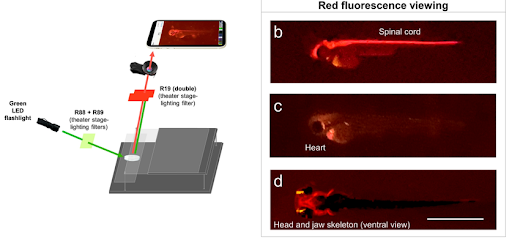In news– Recently, a design for a Glow Scope, a Fluorescence Microscope, has been developed by scientists at Winona State University in Minnesota.
What is fluorescence microscopy?
- An optical microscope views an object by studying how it absorbs, reflects or scatters visible light.
- A fluorescence microscope views an object by studying how it reemits light that it has absorbed, i.e. how it fluoresces. This is its basic principle.
- The object is illuminated with light of a specific wavelength. Particles in the object absorb this light and reemit it at a higher wavelength (i.e. different colour). These particles are called fluorophores; the object is infused with them before being placed under the microscope.
- There are versions of fluorescent microscopes with more sophisticated abilities, such as epifluorescence and confocal laser-scanning microscopes.
- When the fluorophores fluoresce, a fluorescent microscope can track them as they move inside the object, revealing the object’s internal shape and other characteristics.
- For example, a fluorophore called the Hoechst stain binds to DNA and is excited by ultraviolet light. So a tissue sample collected from a person could be injected with the Hoechst stain and placed under a fluorescent microscope.
- When the sample is illuminated by ultraviolet light, the stain absorbs the light and reemits it at a higher wavelength.
- The microscope will point out where this is happening: in the nuclei of cells, where DNA is located. This way, the nuclei in the tissue can be labelled for further study.
- Scientists have developed different fluorophores to identify and study different entities, from specific parts of DNA to protein complexes. On the flip side, fluorescence microscopes cost at least a lakh rupees, but often up to crores.
How does the new device improve access?
- In the new study, researchers from Winona State University have described a rudimentary fluorescence microscope that they say can be put together at a cost of $30-50 (Rs 2,500-4,100).
- They haved demonstrated the ability of these device to detect green and red fluorophores and to monitor and detect changes to heart rate and rhythmicity in embryonic zebrafish.
- Their setup consists of two plexiglass surfaces, an LED flashlight, three theatre stage-lighting filters, a clip-on macro lens, and a smartphone.
- The smartphone (with the lens attached) is placed on one surface that is suspended at a height (say, a foot above). The second sheet is placed below and holds the object.

- In their study, the objects were zebrafish embryos in a petri dish, prepared according to well-established guidelines to ensure they aren’t harmed.
- They were injected with different fluorophores depending on which part of the embryos were of interest. The sources of illumination were also LED flashlights emitting light of correspondingly different wavelengths.
- One of the stage-lighting filters was held between the flashlight and the object and the other two were held between the object and the smartphone.
- The role of these filters was to ensure that light of the right frequency reached the object and that fluoresced light of a suitable frequency reached the camera.
- With this setup, the researchers were able to image the creatures’ brain, spinal cord (using a fluorophore called DsRed), heart (mCherry), and head and jaw bones (mRFP).
- They were able to zoom in and out using the smartphone camera and the clip-on lens, and by adjusting the distance between the sample and the smartphone platforms.
Source: The Hindu














